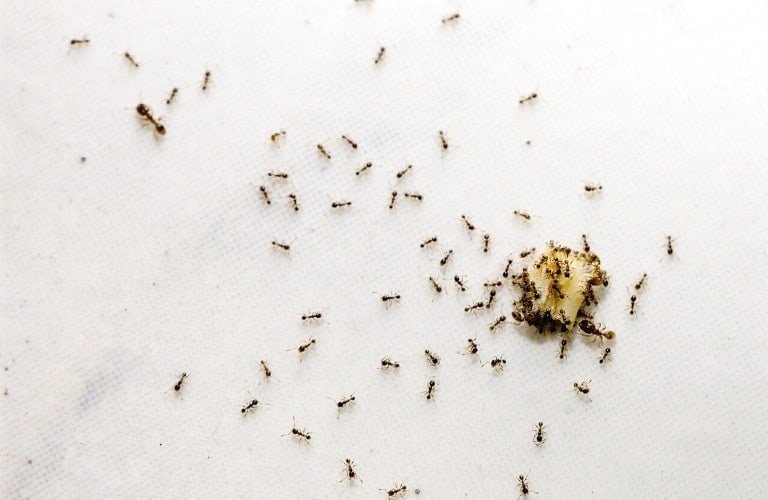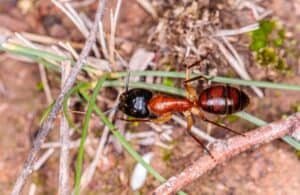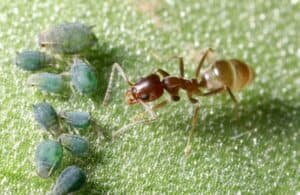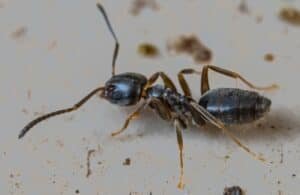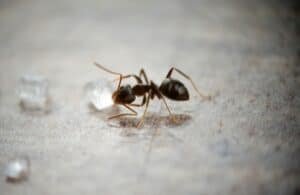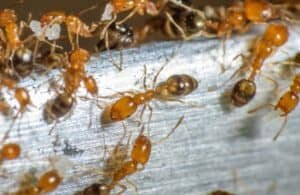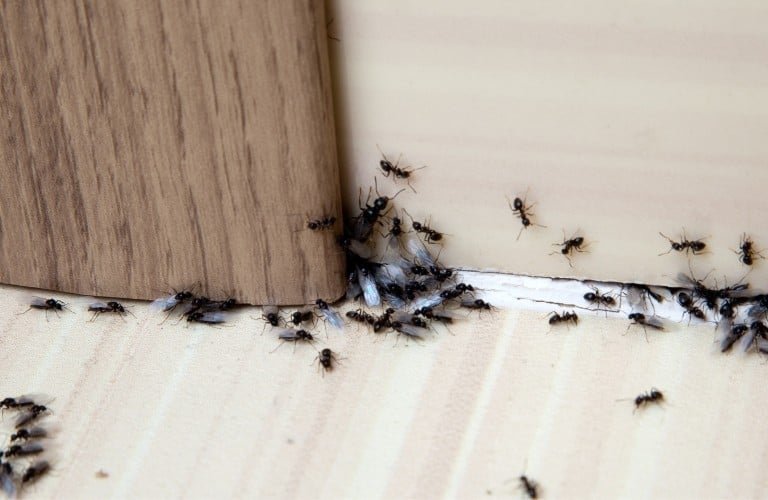You may have heard of sugar ants and assume that the ones going after the crumbs of cake are indeed sugar ants. That may or may not be true, however.
What are sugar ants, and how can you get rid of them? The term sugar ants is an encompassing name applied to several species of ants that rely on sugar as their main food source. Examples of “sugar ants” include banded sugar, Argentine, carpenter, and pavement ants. Boric acid mixed with sugar will attract and kill them.
There are thousands of species of ants, and several of them are nicknamed sugar ants.
Let’s take a look at the different species that might be in your area, along with ways you can get rid of them.
Identifying Sugar Ants
“Sugar ant” is a term used to identify ants that like to eat sugar. There are some species that prefer to eat proteins, and these are appropriately called protein ants.
These two types of ants are commonly found invading homes in search of food.
Protein ants and sugar ants have their preferences, but they’ll eat whatever is available if they need it.
Banded Sugar Ants
There is an ant that’s actually called a sugar ant – the banded sugar ant. It’s native to Australia but can be found all across North America.
Its body is mostly red or brown but could have black on either end of the body. Sometimes the entire body can be black.
They like to make their nests in wood, roots, and branches of plants and under rocks and paving stones.
They like to eat plant nectar, so if you have them around your home, you should check around flower beds.
Common Sugar Ants
Some of the most common sugar ants you can find in North America include:
Argentine Ant
This is an invasive brown and yellow ant that will take over other ant colonies, even if they’re a different species.
They like to live in buildings, so they can easily become a nuisance.
Carpenter Ant
This solid black ant likes to chew through wood to make their nest. They don’t eat the wood, so they’ll go search for sugary sources of food.
They can house themselves in your trees or house.
Odorous House Ant
This brown ant prefers to eat the product left behind by aphids, which is called honeydew.
If you have a flower or vegetable garden and odorous house ants live in your area, you can expect to see them all over your flowers if you have aphids.
Pavement Ant
This ant is the species that is most commonly called a sugar ant.
They’re the most common ant in North America, and they’ll easily find their way into kitchens or wherever food is left behind.
They’re usually brown and on the smaller side.
Pharaoh Ant
This yellow ant is only 2 millimeters long but has become an invasive pest in many buildings since they’ll eat sugar, protein, and dead insects.
They can be hard to see because of their size and neutral color.
Did you know that ants are actually a sign of a healthy, stable ecosystem? Find out how ants benefit the environment here.
Why Sugar Ants Are Coming Inside
The main reason sugar ants are finding their way inside is that they found a food source.
This food source could be anything – packaged food in a pantry, food that has fallen between couch cushions or under furniture, or even a few crumbs hidden in a rug.
Since ants are so small, it doesn’t take much for them to be well fed.
Another reason ants make their way into your home is to build nests. They usually start building nests in homes if they have a good food source inside your home somewhere.
They can build homes in the walls or in basements, and sometimes they might do so in the attic.
It may seem as if these industrious workers are constantly going about their duties as they seek food and nesting locations.
However, you may be surprised to learn that ants do in fact sleep, just not in the same way we do.
Find out how and how often ants stop to get some much-needed rest in this article.
How to Prevent Sugar Ants
Ant prevention is easy to accomplish and can save you from potentially being bitten one day. Is it really true that all ants can bite? We answer that in this article.
Taking a few steps before you ever see ants can save you from a major infestation later.
Keep Your Home Clean
Rule number one for preventing sugar ants is to keep your home clean. Don’t allow crumbs and pieces of food to stick around for too long.
If your home doesn’t provide a food source, the ants will have no reason to come inside.
- Vacuum, sweep, and mop regularly.
- Don’t leave dirty dishes sitting around for too long.
- Pick up all trash after eating outside.
- Be mindful of what crumbs you’re dropping when eating outside.
- Be sure that all pet food is stored securely in containers with tight-fitting lids.
Be Smart About Food Storage
Ants are capable of chewing through several materials (remember, carpenter ants will chew through wood).
Where you store your food and how you store it should be carefully thought out, especially if you’ve dealt with ant problems in the past.
- Make sure packaging is sealed: Cardboard boxes and plastic bags are prone to tearing or wearing down. If a box of pasta or a bag of cereal develops an opening, ants will be able to find it. Inspect each item before you put it into the pantry.
- Use airtight containers: Airtight containers will eliminate the need to check the boxes and bags all the time. Transfer as much stored food as possible to containers like these. They also make it easy to organize and see how much you have left, so it’s a win-win for you.
- Don’t leave food near windows: Some people like to let food cool on a windowsill when the breeze is cool. This is a sure way to invite ants into your home. If you have windows in your kitchen, find an area away from them to leave food out to cool.
- Put away food if you’re not eating it: This is especially important if you’re eating outside.
Seal Cracks and Crevices
Since ants can be just 1 or 2 millimeters in length, sealing up cracks might seem like a futile attempt.
You should still do this though, even if it seems like it won’t help much. The bigger cracks can lead to large gaps in the walls, which will be perfect for new nests inside your walls.
Use caulk to take care of areas around windows and doors. Weatherstrips can prevent them from crawling underneath doors.
Replace screens as soon as they tear, and routinely check around your home for new openings that pop up.
How to Get Rid of Sugar Ants
Once you spot ants, you should begin with the prevention steps if you haven’t done so already. Removing food and sealing cracks will help stop others from coming inside.
Our article “How to Get Rid of Ants” provides a complete prevention guide and presents both natural and chemical elimination methods to choose from in your battle against ants.
There are several ways to get rid of ants, but using boric acid with a sugary substance is the best way to go for sugar ants.
They’re after sugar, so by providing them with what their after along with a little poison, you’ll eventually kill the entire colony.
- Mix ½ – 1 tablespoon of boric acid with 2-3 tablespoons of maple syrup. It should have a consistency of glue or paste.
- Spread the mixture onto a flat surface like piece of cardboard and lay it out so the ants can easily access it.
It might take some time for it to begin working.
At first you’ll see more ants because you’ve provided a food source, but after a week or two, you’ll start to see the number of them dwindle.
If you keep providing this mixture, you’ll eventually kill the entire colony. If they take the food back to the colony and feed the queen, you’ll eventually run out of ants completely.
Here are a few other options.
Smother With Cornstarch
If you spot a pile of ants around a food source, pour cornstarch on them followed by some water. This will suffocate them and kill them immediately.
It’s a messy process, but it’s a handy way to kill several at once.
Deter Them With Strong Odors
Ants don’t like the scents of citrus, peppermint, coffee grounds, vinegar, black pepper, or eucalyptus oil. You can use these ingredients in DIY sprays to make them leave the area.
Spray them where ants congregate as well as over all entry points. This will deter them and give you a chance to to use other measures to make sure they stay away.
This method can also help deter a swarm of flying ants from settling on your property.
Wait – flying ants? Yes, they are real. Find out exactly what flying ants are here.
Pesticides
Pesticides should be the last resort since they have harmful chemicals in them.
(To see what your options are as far as outdoor ant killers are concerned, head over to this article to see our top recommendations.)
If you’re in a pinch, aerosol sprays, like this one that sprays up to 15 feet, kill on contact.
Liquid sprays will leave behind a residue that will kill for several weeks or longer, depending on the product.
For example, Ortho Home Defence will continue to be effective for up to one year after initial application as long as the area remains dry.
There are also bait traps similar to the DIY version mentioned above that you can use if you don’t want to spray pesticides everywhere.
These traps come prebaited with a scent that ants find irresistible, and the included stakes make securing them in place easy.
For large infestations where you would prefer not to apply chemicals, these are an ideal choice.
Exterminators
You don’t have to raise the white flag if you can’t find a solution. An exterminator will be able to kill all the ants for you as well as find the source of the problem.
Final Thoughts
Sugar ants can easily find their way into your home with a food source and a way inside.
Make sure there isn’t anything for them to eat and that they don’t have an easy way into your home, and you won’t have to worry about them.
Sugar ants prefer to eat sugar, but they won’t turn down proteins if that’s the only option available.
Be sure to check out all of our ant articles for more prevention tips, elimination methods, and recommended products to help banish ants from your home and yard. Access them all here.

